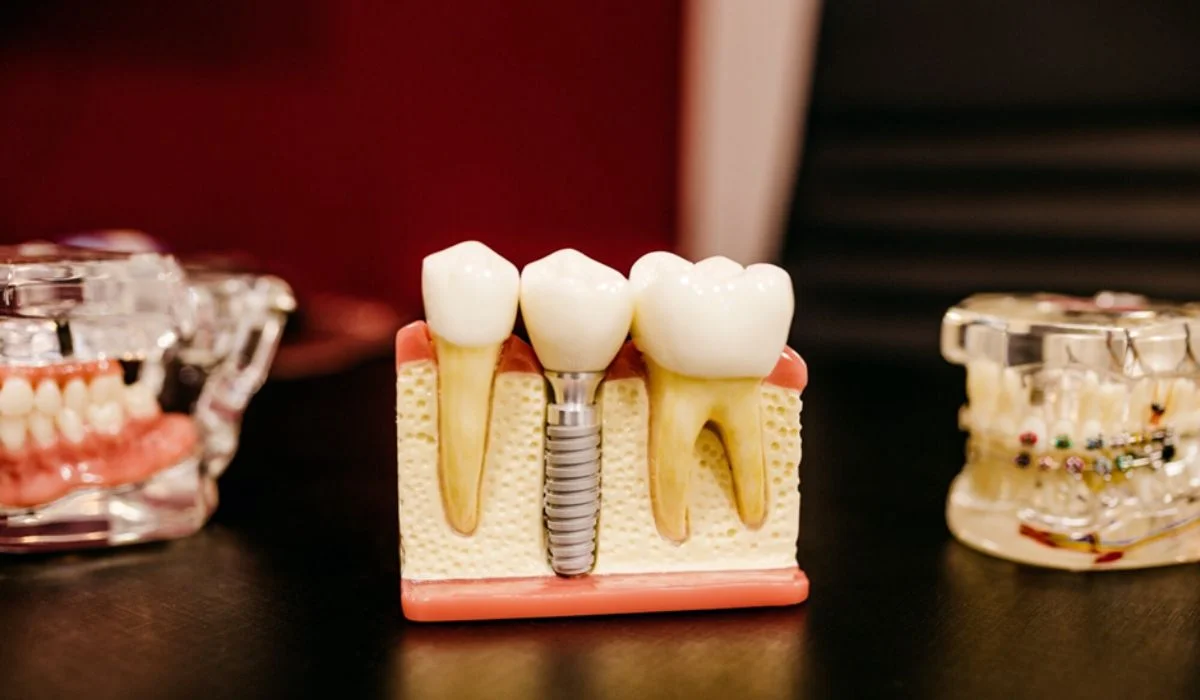Uncategorized
From Start to Finish: The Process of Getting the Best Teeth Implants

Dental implants are a popular solution for people who have missing or damaged teeth. They provide a strong foundation for permanent or removable replacement teeth that are made to match your natural teeth.
If you’re considering dental implants, it’s important to understand the entire process from start to finish. Here’s a comprehensive guide to help you know what to expect in getting the best teeth implants.
What Are Dental Implants?
Artificial tooth roots, known as dental implants, are placed into the mandible and are usually composed of titanium. They act as a foundation for synthetic teeth (crowns) that mimic natural teeth in both appearance and functionality. Dental implant treatment can replace a single tooth, multiple teeth, or even a full set of teeth.
Why Choose Dental Implants?
Dental implants are becoming the go-to solution for tooth replacement. They offer many benefits over traditional options like dentures or bridges. If you’re considering dental implants, here are some key reasons why they might be the best choice for you.
Natural Look and Feel
Dental implants are designed to look and feel like your natural teeth. The color, shape, and size can be matched to your existing teeth. This means they blend seamlessly with your smile. Unlike dentures, you don’t have to worry about them slipping or looking out of place.
Improved Comfort
Since dental implants are fused to your jawbone, they become a part of you. This eliminates the discomfort of removable dentures. You won’t have to deal with the hassle of taking them out and putting them back in. Once placed, dental implants feel as natural as your own teeth.
Enhanced Eating and Speaking
Dental implants function like natural teeth. This means you can eat your favorite foods without any worries. Hard or sticky foods won’t be a problem. With traditional dentures, you might struggle with certain foods or face embarrassing slips while speaking. Implants give you the confidence to enjoy meals and conversations.
Durability and Longevity
With proper care, dental implants can last a lifetime. They are made from durable materials like titanium, which is biocompatible and integrates well with the jawbone. Traditional bridges might need to be replaced after 10-15 years, but implants provide a more permanent solution.
Better Oral Health
Dental implants don’t require altering adjacent teeth. In contrast, a dental bridge needs the support of neighboring teeth, which might involve grinding them down. With implants, your natural teeth are left intact. This helps to maintain your oral health in the long run.
Prevention of Bone Loss
One unique advantage of dental implants is that they help prevent bone loss. When you lose a tooth, the jawbone in that area starts to deteriorate. Implants stimulate the jawbone just like natural teeth, preventing bone loss and maintaining the structure of your face.
Boosted Self-Esteem
A missing tooth can affect your confidence. Dental implants restore your smile, boosting your self-esteem. You won’t feel self-conscious about gaps or ill-fitting dentures. Having a complete, natural smile can improve your overall quality of life.
Easy Maintenance
Maintaining dental implants is simple. Just brush and floss them like your natural teeth. There’s no need for special adhesives or cleaning solutions, unlike dentures. Regular dental check-ups will ensure your implants stay in perfect condition.
Cost-Effective in the Long Run
While the upfront cost of dental implants can be higher than other options, they are cost-effective in the long run. Considering their durability and minimal maintenance costs, implants can save you money over time. You won’t need frequent replacements or special products for upkeep.
Versatility
Dental implants are versatile. They can replace a single tooth, or multiple teeth, or even support a full set of dentures. This flexibility makes them suitable for a wide range of dental restoration needs.
Step-by-Step Process of Getting Dental Implants
If you’re thinking about getting dental implants, it’s natural to have many questions. This guide will walk you through the simple steps involved in the process. By the end, you’ll have a clear understanding of what to expect.
Initial Consultation
Your journey starts with a visit to your dentist. During this consultation, you will discuss your dental health, medical history, and your expectations. The dentist will examine your mouth and take X-rays or scans. This helps them determine if you have enough bone to support an implant. If you don’t, don’t worry! There are ways to fix this.
Treatment Plan
Based on the initial consultation, your dentist will create a dental treatment plan tailored to your needs. This plan will outline the number of implants required, the type of implants best suited for you, and the timeline for your treatment.
Preparing for Surgery
Before the actual implant procedure, you may need some preparatory treatments. If you lack enough bone, a bone graft might be necessary. This involves adding bone material to your jaw to make it strong enough to support an implant. If you have any damaged teeth that need removal, this will also be done before placing the implants.
Implant Placement
Once your mouth is ready, the implant placement surgery will be scheduled. You will receive local anesthesia to numb the area where the implant will be placed.
The dentist makes a small cut in your gum to expose the bone. They then drill a small hole in the bone and place the titanium implant into it. The gum is stitched back over the implant.
This part of the process usually takes about 1-2 hours per implant.
Healing Period (Osseointegration)
After the implant is placed, your body needs time to heal. This period is called osseointegration. During this time, the implant fuses with your jawbone, creating a strong and stable base for the artificial tooth. This healing process can take anywhere from 3 to 6 months. During this period, it’s important to follow your dentist’s dental care instructions to ensure proper healing.
Attaching the Abutment
Once osseointegration is complete, the next step is to attach the abutment. The abutment is a small connector that attaches the implant to the artificial tooth. To do this, the dentist reopens your gum to expose the implant. They then screw the abutment onto the implant and close the gum around it. This is a minor procedure and typically requires only local anesthesia.
Creating the Crown
While your gum heals around the abutment, your dentist will create a custom crown (artificial tooth) that matches the shape, size, and color of your natural teeth. This crown will be attached to the abutment.
Placing the Crown
Once the crown is ready, you’ll return to the dentist for the final step. The dentist will attach the crown to the abutment, completing your dental implant process. You now have a new, fully functional tooth!
Follow-Up Care
After your implant is placed, regular follow-up visits to the dentist are essential. These visits ensure that the implant is functioning well and your oral health is maintained.
The Potential Risks and Complications of Dental Implants
While they boast a high success rate, it’s important to be aware of the potential risks and complications associated with dental implants. Understanding these risks can help you make an informed decision and prepare for a smoother recovery process.
Infection at the Implant Site
One of the most common complications following dental implant surgery is infection. This can occur if bacteria enter the implant site during or after the procedure. Signs of infection include redness, swelling, pain, and discharge around the implant area.
Implant Failure
Although rare, dental implants can fail. Implant failure can occur immediately after surgery or months later. Factors contributing to implant failure include poor bone quality or quantity, improper implant placement, or excessive stress on the implant. Smokers and individuals with chronic conditions like diabetes are at higher risk for implant failure.
Nerve Damage
Nerve damage is a potential risk when implant placement is too close to the nerves in your jawbone. Symptoms of nerve damage include numbness, tingling, or pain in the teeth, gums, lips, or chin. In some cases, nerve damage can be temporary, but it can also be permanent if not addressed quickly.
Sinus Problems
For implants placed in the upper jaw, there’s a risk of sinus complications. If the implant protrudes into the sinus cavity, it can cause sinus infections or other issues. To avoid this, your dentist may perform a sinus lift before placing the implant to ensure there is enough bone to support it.
Peri-Implantitis
Peri-implantitis is an inflammatory condition affecting the gums and bone around a dental implant. It’s similar to gum disease and can lead to bone loss and implant failure if left untreated. Good oral hygiene, regular dental check-ups, and avoiding smoking can help prevent peri-implantitis.
Allergic Reactions
Although rare, some individuals may experience allergic reactions to the materials used in dental implants, such as titanium. Symptoms can include swelling, itching, or rash. If you have a known metal allergy, inform your dentist before the procedure. Alternative materials, such as zirconia, can be considered in such cases.
Getting the Best Teeth Implants
The best teeth implants are a long-lasting, effective solution for replacing missing or damaged teeth. From the initial consultation to the final placement of the crown, the process involves several steps that require time and commitment. However, the end result is well worth an attractive, functional smile that can last a lifetime.
If you’re considering dental implants, consult with a qualified dental professional to discuss your options and develop a personalized treatment plan.
For more topics aside from oral health care, visit our blog!
TECHNOLOGY
Lessons from Growing TikTok Pages: The Power of Dedicated Mobile IPs and Direct Lines in 2026

As someone who’s been deeply involved in TikTok growth strategies for the past few years, I’ve managed dozens of accounts across niches like lifestyle, e-commerce dropshipping, and viral challenges. In 2026, the platform is smarter than ever—shadowbans, account suspensions, and algorithm tweaks hit harder if you’re not careful at growing TikTok pages. What I’ve learned the hard way is that success at scale boils down to one thing: mimicking real mobile users perfectly. That’s where dedicated mobile IPs and specialized direct lines come in. They’ve been game-changers for me, allowing me to grow pages from zero to hundreds of thousands of followers without constant setbacks.
My Early Struggles with TikTok Account Management
When I started farming multiple TikTok accounts in 2023, I relied on cheap datacenter proxies. Big mistake. TikTok’s anti-bot systems flagged them almost immediately—IPs looked suspicious, engagement dropped, and accounts got limited. Switching to basic residential proxies helped a bit, but rotation was too aggressive for long sessions like posting schedules or live streams. I needed something that behaved like a genuine smartphone on cellular data: stable for hours when required, but rotatable to avoid detection during bulk actions.
That’s when I dove into mobile proxies. These use real 4G/5G connections from carriers, giving your traffic the highest trust score possible. No more “data center” fingerprints—TikTok sees you as a legit mobile user.
Discovering Dedicated Mobile IPs for Stability
For accounts that need consistency (think main pages where I handle daily posting, commenting, and analytics), I turned to static mobile proxies—also called dedicated or sticky mobile IPs. These assign you a fixed mobile IP that stays the same for days or weeks, perfect for maintaining sessions without logging out repeatedly.
I started using OKKProxy’s mobile static proxies, which offer real 4G/5G IPs from trusted carriers in over 100 countries. The precision targeting—down to city, state, or even carrier—let me assign location-specific IPs to accounts, making growth feel organic. Response times around 0.5 seconds and unlimited concurrent connections meant I could run multiple devices smoothly. For long-session tasks like TikTok account management, these bypassed risk controls effortlessly. No more random verifications or bans during uploads.

In contrast, for high-volume actions like liking, following, or testing new content across fresh accounts, dynamic options shine.
Dynamic vs. Static Mobile Proxies: Quick Comparison
| Feature | Dynamic Mobile Proxies | Static Mobile Proxies |
| IP Behavior | Automatic rotation (fresh IP per request or interval) | Fixed IP for long sessions |
| Best For | Bulk actions, avoiding rate limits | Account logins, posting, analytics |
| Anonymity Level | High (constant change) | High (persistent sessions) |
| TikTok Use Case | Farming new accounts, automation | Managing established pages |
| Example Provider | OKKProxy Dynamic (600K+ pool) | OKKProxy Static (global 4G/5G) |
OKKProxy’s dynamic mobile proxies became my go-to for rotation-heavy workflows. With over 600K real mobile IPs, HTTP/SOCKS5 support, and sub-0.4s speeds, they handled geo-scraping trends or multi-account engagement without blocks. The 99.99% stability was a lifesaver during peak hours.

The Rise of TikTok-Specific Direct Lines
As TikTok tightened mobile detection in 2025-2026, general mobile proxies weren’t always enough for ultra-sensitive actions. I needed something optimized exclusively for the platform—enter TikTok direct lines.

These are dedicated proxy connections routed through clean, platform-approved mobile paths, often called “TikTok proxy services” or direct residential lines. I discovered Niuproxy, a provider specializing in this. Their TikTok direct line service offers tailored proxies that connect straight through high-trust mobile networks, minimizing latency and maximizing bypass rates for TikTok’s unique fingerprinting.
Niuproxy’s setup was perfect for my automation scripts—direct lines reduced detection to near zero, even when running 50+ accounts simultaneously. Combined with tools for organic growth, it let me scale viral campaigns without shadowbans. If you’re deep into TikTok proxies in 2026, something like Niuproxy’s dedicated TikTok lines is essential for advanced users.
Key Lessons I’ve Learned in 2026
1. Mix Static and Dynamic: Use dedicated mobile IPs (like OKKProxy static) for core accounts and rotating ones for support tasks.
2. Platform-Specific Tools Matter: For pure TikTok focus, add direct lines—Niuproxy excels here.
3. Geo-Targeting is Crucial: Match IPs to your audience’s location to boost algorithm favor.
4. Test Small, Scale Big: Always trial proxies on a few accounts first.
FAQs from My Experience
Q: Are mobile proxies worth the cost for TikTok growth?
A: Yes — especially in 2026. Real mobile proxies (4G/5G) significantly reduce the risk of TikTok account bans and shadowbans, helping you maintain long-term account stability while growing safely.
Q: How do I avoid TikTok bans with proxies?
A: Stick to real 4G/5G mobile IPs, rotate wisely, and use direct lines for TikTok-heavy workflows.
Q: What’s better—general mobile proxies or TikTok-specific?
A: Both. OKKProxy for broad mobile needs; Niuproxy for specialized TikTok direct access.
Final Thoughts
Growing TikTok pages in 2026 demands smart tools growing TikTok pages. Dedicated mobile IPs and direct lines have powered my biggest wins, turning frustrating bans into consistent gains. If you’re managing multiple accounts or automating at scale, start with reliable mobile proxies for TikTok like those from OKKProxy, and layer in TikTok-specific services like Niuproxy’s direct lines. It’s not just about more traffic—it’s about smarter, undetectable access.
Uncategorized
Barbells and Beyond: The Allure of Apadravya Piercing

Apadravya piercing is a type of genital piercing primarily performed on the penis. It involves the insertion of a barbell horizontally through the glans of the penis, passing through the urethra. This piercing is known for its aesthetic appeal and potential enhancement of sexual pleasure.
The History and Cultural Significance of Apadravya Piercing
The practice of genital piercing dates back centuries and holds cultural significance in various societies worldwide. Historically, genital piercings were associated with rituals, rites of passage, or markers of social status. In some cultures, genital piercings were believed to enhance fertility or sexual potency.
Understanding the Procedure
Preparing for Apadravya Piercing
Before undergoing an Apadravya piercing, it’s crucial to choose a reputable and experienced piercer. Additionally, proper hygiene and genital grooming are essential to reduce the risk of infection during and after the procedure.
The Piercing Process
During the piercing process, the piercer will clean and sterilize the genital area before marking the entry and exit points for the piercing. Local anesthesia may be administered to minimize discomfort. The piercing needle is then carefully inserted, followed by the insertion of the barbell.
Aftercare and Healing
After the piercing, diligent aftercare is essential to promote proper healing and reduce the risk of complications. This includes cleaning the piercing with saline solution, avoiding sexual activity or rough handling of the piercing, and wearing loose-fitting clothing to prevent irritation.
Pain, Risks, and Safety Concerns
While Apadravya piercing is generally considered safe when performed by a professional, it is not without risks. Pain levels vary from person to person, but most individuals report moderate discomfort during the procedure and mild to moderate pain during the healing process.
Choosing Jewelry for Apadravya Piercing
Selecting the right jewelry for an Apadravya piercing is crucial for both aesthetics and comfort. Surgical-grade stainless steel or titanium barbells are commonly recommended due to their biocompatibility and durability.
ALSO READ: THIGH TATTOOS: A CANVAS OF EXPRESSION AND STYLE
Apadravya Piercing: Myths vs. Facts
There are many misconceptions surrounding Apadravya piercing, including beliefs about pain, sexual function, and hygiene. It’s essential to separate fact from fiction to make informed decisions about genital piercing.
Pros and Cons of Apadravya Piercing
Like any form of body modification, Apadravya’s piercing has its advantages and disadvantages. Pros may include aesthetic appeal, potential sexual enhancement, and personal expression, while cons may include pain, risks of infection, and social stigma.
Conclusion
Apadravya piercing is a significant form of self-expression and body modification with a rich history and cultural significance. By understanding the procedure, risks, and aftercare involved, individuals can make informed decisions about whether Apadravya piercing is right for them.
ALSO READ: MEMENTO VIVERE TATTOO: A TIMELESS REMINDER
FAQs
What is Apadravya?
Apadravya is a genital piercing where a barbell is inserted horizontally through the glans of the penis, passing through the urethra. It is valued for its aesthetic appeal and potential sexual enhancement.
Is Apadravya piercing painful?
Pain levels vary, but most people experience moderate discomfort during the procedure and mild to moderate pain while healing. Proper aftercare can help alleviate discomfort.
How can I find a reputable piercer for Apadravya piercing?
Look for experienced piercers with positive reviews and strict hygiene standards. Check their portfolio and ask about their sterilization practices before making an appointment.
Are there age restrictions for getting an Apadravya piercing?
Typically, individuals must be at least 18 years old. Some piercers may require parental consent for minors.
Can Apadravya’s piercing affect sexual function?
While rare, complications like nerve damage or scarring can affect sexual function. It’s important to consult with a qualified piercer about any potential risks.
Uncategorized
The Game Archives Gameverse Unveiled

Welcome to the exciting world of Game Archives Gameverse, where gaming history meets cutting-edge technology to create a gaming platform like no other. Dive into this immersive universe where classic games and modern innovations collide to offer gamers an unparalleled experience. Join us as we explore the evolution, features, successful case studies, and future plans of the Game Archives Gameverse – your gateway to endless gaming possibilities!
The History and Evolution of Game Archives
The history and evolution of game archives is a fascinating journey through the digital landscape of gaming. It all began with humble beginnings, where gamers sought ways to preserve their favorite games for future enjoyment. As technology advanced, so did the methods of archiving these virtual worlds.
From early floppy disks to CDs and DVDs, game archives have come a long way in preserving gaming classics. The transition to online platforms revolutionized how games were stored and accessed by players worldwide. This shift paved the way for more efficient archiving systems that could house vast libraries of games.
With each new innovation, game archives expanded their reach and capabilities, ensuring that beloved titles would not be lost to time. Today, the Game Archives Gameverse stands as a testament to this rich history, providing a platform where gamers can explore a treasure trove of timeless classics and modern favorites alike.
Features and Benefits of Using Gameverse
Gameverse offers a multitude of features that cater to both gamers and game developers alike. One key feature is its user-friendly interface, making navigation seamless for users of all levels. With Gameverse, players can discover a wide array of games from various genres in one centralized platform.
Another benefit is the personalized experience it provides. By curating game recommendations based on individual preferences, Gameverse enhances the gaming journey for each user. Additionally, the platform fosters community engagement through forums and social sharing options.
For developers, Gameverse offers a valuable opportunity to showcase their creations to a diverse audience. The platform’s analytics tools provide insightful data on player behavior and preferences, aiding developers in refining their games for optimal performance.
Furthermore, Gameverse supports cross-platform compatibility, allowing games to reach a broader audience across different devices. This flexibility not only benefits developers but also ensures accessibility for players wherever they may be.
How to Access and Use the game archives Gameverse?
To access the Game Archives Gameverse platform, simply visit their website and create an account. Once registered, you can browse through a diverse collection of games spanning various genres and platforms. The user-friendly interface allows for easy navigation, making it simple to discover new titles or revisit old favorites.
Using Gameverse is straightforward – select a game from the library and start playing instantly without any downloads or installations required. The platform offers seamless gameplay with no interruptions or lags, ensuring a smooth gaming experience for all users. Engage in single-player campaigns, multiplayer matches, or explore interactive storytelling adventures at your convenience.
Furthermore, Game Archives provides regular updates and additions to its game library so that players always have fresh content to enjoy. Whether you’re a casual gamer looking for quick entertainment or a dedicated player seeking immersive experiences, Gameverse has something for everyone.
Case Studies: Successful Games on the Gameverse Platform
Dive into the world of Gameverse, where successful games come to shine. One standout example is “Galactic Quest,” a space exploration game that captivated players with its stunning visuals and immersive gameplay. With Gameverse’s user-friendly interface, “Galactic Quest” quickly gained a loyal following.
Another hit on the platform is “Fantasy Realms,” an epic adventure game that transported players to magical realms filled with mythical creatures and quests. The seamless integration of in-game rewards through Gameverse kept players engaged and coming back for more.
“Virtual Racer,” a high-speed racing simulation, also found success on Gameverse by offering realistic driving mechanics and multiplayer competitions. Players could easily connect with friends and compete in adrenaline-pumping races.
These case studies illustrate how Gameverse has become a hub for innovative and engaging gaming experiences, attracting both developers and gamers alike.
Future Plans for Game Archives and the Gameverse
Exciting times lie ahead for the Game Archives and its innovative Gameverse platform. The future plans aim to expand the library of games available, offering a diverse range of genres to cater to all gamers’ preferences. Collaborations with indie developers are in the pipeline, fostering creativity and bringing fresh, unique gaming experiences to users.
Enhancements in user interface and experience are on the horizon, ensuring seamless navigation and immersive gameplay. Integration of new technologies such as VR and AR will elevate gaming interactions to a whole new level, promising an exciting evolution in virtual entertainment.
Community engagement initiatives will be a key focus moving forward, with tournaments, challenges, and events planned to foster camaraderie among players. Feedback mechanisms will also be enhanced to gather valuable insights from users for continuous improvement and innovation within the Gameverse ecosystem.
Stay tuned as Game Archives continues its journey towards shaping the future of gaming through cutting-edge technology and unprecedented user experiences. The possibilities are endless, making every gamer’s dream adventure just a click away!
Conclusion
In a dynamic gaming landscape where innovation is key, the Game Archives Gameverse emerges as a beacon of creativity and ingenuity. With its rich history, diverse features, and promising future plans, it is evident that the platform is set to revolutionize how gamers engage with their favorite titles.
As we delve deeper into the world of Gameverse, it becomes apparent that this platform offers more than just a place to play games—it fosters community, encourages exploration, and provides a space for both developers and players to thrive. The success stories showcased on Gameverse serve as testaments to its effectiveness in elevating gaming experiences.
Looking ahead, the future of Game Archives and the Gameverse holds boundless possibilities. With a commitment to constant improvement and adaptation to meet evolving needs in the gaming industry, this platform is poised for continued growth and success.
So whether you’re a seasoned gamer or just starting your journey into the world of interactive entertainment, consider exploring what the Game Archives Gameverse has to offer. It’s not just about playing games; it’s about embracing an immersive gaming experience like never before. Join us on this exciting adventure through digital realms where possibilities are endless!
What is “The Game Archives Gameverse”?
The Game Archives Gameverse is a revolutionary platform uniting classic and modern games in one immersive digital universe. It offers a centralized hub where gamers can explore, play, and discover a diverse array of gaming experiences.
Why are Game Archives important for gamers?
Game Archives preserve gaming history by storing and making accessible older games that might otherwise be lost. They provide a treasure trove of nostalgia and educational value while ensuring these games remain playable for future generations.
How does the Gameverse enhance gaming experiences?
Gameverse enriches gaming experiences through its user-friendly interface and curated game collections. It offers personalized recommendations, community engagement features, and seamless gameplay across multiple platforms.
Can developers benefit from the Game Archives Gameverse?
Yes, developers can showcase their games to a wide audience, gather player insights through analytics, and foster community interaction. The platform supports indie developers and promotes creativity in game development.
What are the future plans for the Game Archives Gameverse?
Future plans include expanding the game library with diverse genres, integrating new technologies like VR and AR, enhancing user interface and experience, and fostering community through tournaments and events.

 BUSINESS10 months ago
BUSINESS10 months agoBrand Visibility with Imprint Now and Custom Poly Mailers

 TECHNOLOGY9 months ago
TECHNOLOGY9 months agoDizipal 608: The Tech Revolution Redefined

 BUSINESS11 months ago
BUSINESS11 months agoExploring the Benefits of Commercial Printing

 HOME IMPROVEMENT10 months ago
HOME IMPROVEMENT10 months agoThe Do’s and Don’ts of Renting Rubbish Bins for Your Next Renovation

 HEALTH6 months ago
HEALTH6 months agoYour Guide to Shedding Pounds in the Digital Age

 HEALTH9 months ago
HEALTH9 months agoHappy Hippo Kratom Reviews: Read Before You Buy!

 HEALTH6 months ago
HEALTH6 months agoThe Surprising Benefits of Weight Loss Peptides You Need to Know

 HOME IMPROVEMENT6 months ago
HOME IMPROVEMENT6 months agoGet Your Grout to Gleam With These Easy-To-Follow Tips












